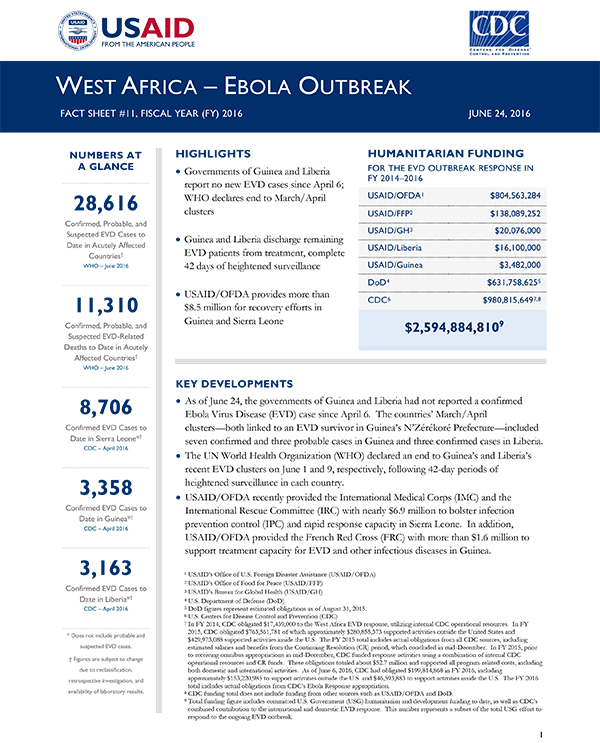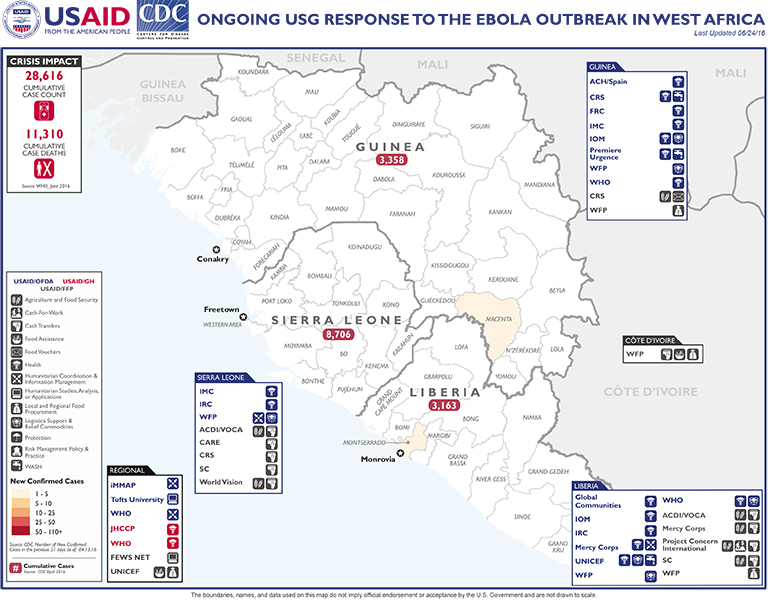June 24, 2016
HIGHLIGHTS
Ebola Response
Visit our main West Africa Ebola Outbreak page to learn more about how we're responding to the West Africa Ebola outbreak, and what you can do to help.
- Governments of Guinea and Liberia report no new EVD cases since April 6; WHO declares end to March/April clusters
- Guinea and Liberia discharge remaining EVD patients from treatment, complete 42 days of heightened surveillance
- USAID/OFDA provides more than $8.5 million for recovery efforts in Guinea and Sierra Leone
KEY DEVELOPMENTS
- As of June 24, the governments of Guinea and Liberia had not reported a confirmed Ebola Virus Disease (EVD) case since April 6. The countries’ March/April clusters—both linked to an EVD survivor in Guinea’s N’Zérékoré Prefecture—included seven confirmed and three probable cases in Guinea and three confirmed cases in Liberia.
- The UN World Health Organization (WHO) declared an end to Guinea’s and Liberia’s recent EVD clusters on June 1 and 9, respectively, following 42-day periods of heightened surveillance in each country.
- USAID/OFDA recently provided the International Medical Corps (IMC) and the International Rescue Committee (IRC) with nearly $6.9 million to bolster infection prevention control (IPC) and rapid response capacity in Sierra Leone. In addition, USAID/OFDA provided the French Red Cross (FRC) with more than $1.6 million to support treatment capacity for EVD and other infectious diseases in Guinea.
Guinea
Between March 17 and April 6, the Government of Guinea (GoG) confirmed seven EVD cases in southeastern Guinea’s N’Zérékoré and Macenta prefectures. The new cases resulted from transmission of residual EVD virus by a survivor in N’Zérekoré, WHO reports. Prior to the recent cluster, the GoG had not confirmed a new EVD case since October 29, 2015.
On April 21, health care workers discharged the final EVD patient in the recent cluster from the EVD treatment unit (ETU) in N’Zérékoré. All contacts of the recently confirmed cases had completed 21 days of monitoring by April 27. During the monitoring period, response actors—including USAID partner the UN World Food Program (WFP)—supported households under observation with cash and food distributions to discourage travel outside affected areas. Between March 24 and April 8, the GoG and WHO administered the EVD vaccine to approximately 1,510 contacts of the recent cases—including more than 240 contacts classified as high-risk—in N’Zérékoré and Macenta. On June 1, WHO declared the end of the cluster, following 42 days with no confirmed EVD cases.
Through more than $3.4 million in USAID/OFDA support, IMC is strengthening community event-based surveillance activities in Guinea, in accordance with WHO guidance for post-EVD recovery efforts. In coordination with Plan International and Première Urgence, IMC is building capacity among community health workers and local health facility staff to quickly identify and communicate EVD and other infectious disease alerts to prefectural- and national-level staff. The non-governmental organizations (NGOs) are also training community health workers to conduct outreach to local households regarding EVD and other infectious diseases.
USAID/OFDA recently provided FRC with more than $1.6 million to bolster treatment for EVD and other infectious diseases and strengthen capacity to contain future EVD outbreaks. With USAID/OFDA assistance, FRC is training Guinean health care workers in Coyah, Forécariah, and Macenta prefectures—considered high-risk for new EVD cases due to potential transmission by EVD survivors—on EVD and infectious disease management. FRC is also maintaining ETUs on standby, capable of reactivating within 48 hours at the request of the GoG, in Forécariah and Macenta. USAID/OFDA previously supported FRC with $4.5 million in FY 2015 assistance to manage the Forécariah ETU, which treated more than 280 people, including 54 confirmed EVD patients—24 of whom were discharged as survivors.
West Africa Map - 06-24-2016 ![]() (pdf - 578k)
(pdf - 578k)
Liberia
Between March 31 and April 5, the Government of Liberia (GoL) confirmed three EVD cases—later linked to the transmission chain from N’Zérékoré—in Liberia’s capital city of Monrovia. The first case, an EVD-positive woman, succumbed to the virus on March 31; health care workers discharged the remaining EVD patients, both children of the EVD-positive woman, from treatment on April 29. On June 9, WHO declared the end of the EVD cluster in Liberia, following a 42-day period of heightened EVD surveillance.
USAID/OFDA partners the International Organization for Migration (IOM), the UN Children’s Fund (UNICEF), WHO, and WFP supported the GoL response to the March/April cluster. UNICEF provided psychosocial support and safe drinking water to families under precautionary observation, and WFP distributed food to affected families and provided logistical support to relief actors. To assist heightened surveillance efforts, IOM expanded border surveillance activities from 26 to more than 50 crossing points in approximately 1,500 communities bordering Guinea. In addition, WHO provided the GoL with epidemiological surveillance, case investigation, and contact tracing support, including conducting on-the-job mentoring and supervision of contact tracers and supporting active case-finding efforts at more than 280 health facilities in Montserrado County. WHO also trained health care workers in Montserrado to report live EVD alerts and provided IPC support—including assessment of IPC gaps and distribution of IPC supplies—to more than 50 health facilities near clinics where the confirmed EVD cases sought care.
In response to the recent cluster, the USAID/OFDA-supported epidemic preparedness and response (EPR) consortium—comprising eight NGO partners—shifted from ongoing preparedness efforts to response activities. In Bong, Lofa, Margibi, Montserrado, and Nimba counties, which either border Guinea or host transitory populations, the EPR consortium assisted case investigation and surveillance, case management, and contact tracing efforts; the implementation of rapid diagnostic tests; and logistical coordination, among other activities. Consortium member Global Communities led disinfection and safe burial efforts, including disinfecting two clinics which treated the March/April cases and increasing its safe burial capacity from five burial teams to eight. Global Communities has managed more than 7,000 safe and dignified burials countrywide since late 2014, and Global Communities-trained burial team members continue to serve on Liberia’s county health teams. USAID/OFDA is supporting IRC with nearly $8.7 million to lead the consortium’s preparedness and response efforts in support of Liberia’s 15 county health teams.
Sierra Leone
USAID/OFDA recently provided IRC with $4 million to continue strengthening adherence to IPC protocols in Sierra Leone’s health facilities, including through ongoing training and mentoring for health care workers at 19 government hospitals. With USAID/OFDA assistance, IRC and other NGO partners are assisting the transition from EVD-specific to comprehensive IPC practices at key health care facilities in Sierra Leone.
Through nearly $3 million in USAID/OFDA assistance, IMC is enhancing community preparedness for future EVD cases and supporting residual rapid response capacity in Sierra Leone. IMC is conducting community outreach regarding EVD prevention and surveillance measures and bolstering the capacity of district-level operations centers to quickly and effectively contain new EVD cases.
Agriculture and Food Security
The EVD outbreak negatively affected food security conditions in acutely EVD-affected countries as a result of restrictions on movements and market activities, lost livelihoods, and other EVD-related shocks. While all three countries are recovering from the outbreak’s negative economic impact, recovery in Sierra Leone has been slower than in Guinea and Liberia. The majority of Sierra Leone’s vulnerable households will experience Stressed—IPC 2—levels of food insecurity through September due to below-average agricultural production, above-average prices, and limited economic activity due to continued Sunday market bans, according to the USAID-funded Famine Early Warning Systems Network (FEWS NET).10 Households in the urban districts of Bo and Port Loko, however, will experience Minimal—IPC Phase 1—levels of food insecurity through September as businesses reopen and markets recover following the end of most EVD-related restrictions. The majority of households in Guinea and Liberia will experience Minimal food insecurity through September due to seasonally typical incomes and food sources, including local crops and imported staples such as rice, FEWS NET reports.
USAID/FFP recently provided Save the Children with nearly $3.2 million to continue providing cash transfers to EVD-affected households in Sierra Leone. Since FY 2014, USAID/FFP has provided more than $138 million in emergency food assistance to vulnerable households in EVD-affected countries.
PUBLIC DONATION INFORMATION
- The most effective way people can assist relief efforts is by making cash contributions to humanitarian organizations that are conducting relief operations. A list of humanitarian organizations that are accepting cash donations for disaster responses around the world can be found at www.interaction.org.
- USAID encourages cash donations because they allow aid professionals to procure the exact items needed (often in the affected region); reduce the burden on scarce resources (such as transportation routes, staff time, and warehouse space); can be transferred very quickly and without transportation costs; support the economy of the disaster-stricken region; and ensure culturally, dietary, and environmentally appropriate assistance.
More information can be found at:
- The Center for International Disaster Information: www.cidi.org or +1.202.821.1999.
- Information on relief activities of the humanitarian community can be found at www.reliefweb.int.
USAID/OFDA bulletins appear on the USAID website at what-we-









Comment
Make a general inquiry or suggest an improvement.